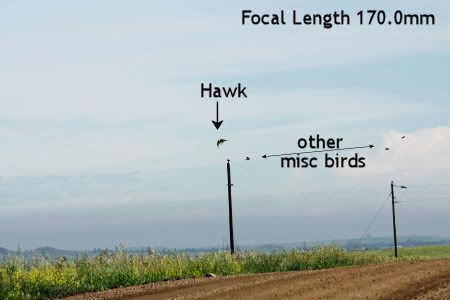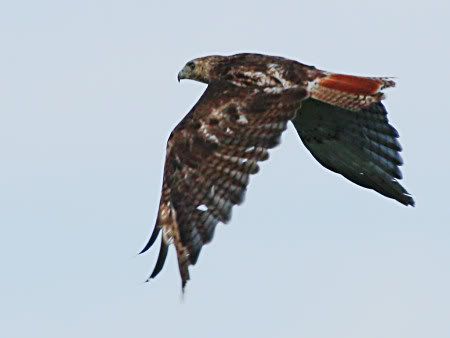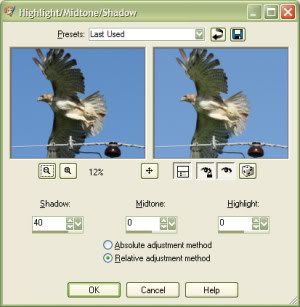Outsmarting the hawk.
The hawks sighted were high atop the powerline poles along the gravel road.
They would stay there IF you just drove by as usual.
If we would stop within photographing distance (70-300mm tele), they would fly away.
You could not stop at a distance and slowly approach on foot either. Forget about it.

The second hawk sighted was more tolerant than the other one and stayed longer. If we stopped, he would fly down about 5 poles and land atop one again. He did this several times so we got several tries.
So...
Our strategy was to drive by about 15-20 mph, and then stop right in front of the pole, with camera ready and focusing.
This strategy of the unexpected seemed to catch the hawk by surprise for a few seconds and I'd get maybe one or two shots in at full stop before he flew off.
(I tried fiddling with different settings on my camera, but that didn't really help much. Probably continuous shooting helped a little. The continuous focusing setting didn't seem to focus well in this situation.)
Success!
I ended up getting the best hawk shots ever, so far.
It was a fun challenge.


Red Tail:

I used Highlights/Midtones/Shadows Photo Adjustment in Paint Shop Pro 9 to lift shadows and bring out more detail.

Red-tailed Hawk Links:
enature
cornell
Red-tailed Hawk (Buteo jamaicensis)
"This is probably the most common hawk in North America. If you’ve got sharp eyes you’ll see several individuals on almost any long car ride, anywhere."
Color Pattern
"Most Red-tailed Hawks are rich brown above and pale below, with a streaked belly and, on the wing underside, a dark bar between shoulder and wrist. The
tail is usually pale below and cinnamon-red above, though in young birds it’s brown and banded. “Dark-phase” birds are all chocolate-brown with a warm red tail. “Rufous-phase” birds are reddish-brown on the chest with a dark belly."
Vision
"Based on the size of their eyes alone, you might guess that birds see extremely well. Their eyes are much larger in proportion to the sizes of their heads than our eyes are.. In fact, some owls and eagles have eyes that are the same size as human eyes, though their heads are much smaller than ours.
Birds' sense of sight is much higher resolution than ours. Hawks, for example, see two to three times as much detail than people do. But most birds do not have the depth perception that we do because of the placement of their eyes. Depth is perceived when each eye provides a slightly different view of the same scene, when there is an overlap in the field of vision. This is known as binocular vision. Birds such as Owls, which have both eyes facing forward, have binocular vision similar to our own, but most nonpredatory birds have eyes whose fields of view do not overlap enough to provide this ability. Instead, their laterally placed eyes give them a wider total view, the better to detect an approaching predator. Scientist believe that to compensate for their lack of binocular vision, some birds bob their heads, thereby viewing the same subject rapidly from different angles. Dippers bob nonstop along mountain streams. Many shorebirds bob rapidly when a predator appears nearby. "
See also: Hearing.
And more.
GOOD informative interesting bird info/diagrams here.

No comments:
Post a Comment